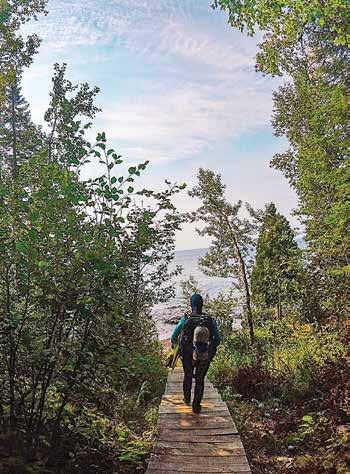
3 minute read
Braving the depths
Local diver finds solace underwater
By Abigail Blonigen
Lake Superior’s notoriously frigid waters keep some people from taking a dip even in the warm summer months.
However, the cold does not deter Laura Schlieman from diving into the coldest, darkest depths of the lake.
“I’ve always been kind of a fish growing up,” said Schlieman, a certified advanced open-water diver. “My family had a lake cabin, and I would be in the water from 7 a.m. to 7 p.m.”
Schlieman moved to Duluth about three years ago for cosmetology school. Growing up on a farm near Appleton, Minnesota, her love of lakes inspired her to move north to the shores of Superior.
Diving is a relatively new endeavor for Schlieman. A few months prior to the pandemic shutdown, she took a trip to Florida and went scuba diving for the first time. After swimming along a reef with the tropical fish, she was hooked.
Upon returning to Duluth, Schlieman connected with Lake Superior Divers Supply and School to learn more about classes and certification.
Lake Superior Divers has been training divers for decades; it was founded in 1956 by Donald Van Nispen, a master diver and expert in boat repair and underwater construction, according to their website.
Schlieman began her training in summer 2020, earning her Professional Association of Diving Instructors (PADI) openwater certification in about six weeks. The courses consist of book work and skills training to learn best practices, general safety and what to do in case of an emergency.
Schlieman did most of her training in Pike Lake, northwest of Duluth. Students work their way up in skill level, beginning by swimming a certain number of yards with just their snorkel and fins on, slowly adding more equipment and distance as they grow more comfortable.
They also learn how to take their masks off and on in the water, how to share air with a partner should their tank malfunction, and how to communicate underwater using hand signals.
The open-water certification permits divers to go up to 60 feet deep in open areas in any body of water. Schlieman took her training a step further to the advanced open-water certification, meaning she can dive up to 130 feet deep.
Schlieman added a few specialty classes to her training as well, including night diving, wreck diving and search and recovery. Night diving involves swimming after dark using special lights and glow sticks. Wreck diving prepares divers to explore sunken ships, planes and vehicles. Search and recovery teaches divers how to find and retrieve sunken items up to 90 pounds.
Other speciality classes offered by Lake Superior Divers Supply and School include boat diving, underwater photography and videography, drysuit diving for colder temperatures and more.

According to the Minnesota Historical Society, there are about 350 known shipwrecks in Lake Superior, though only half have been discovered. The 1905 Madeira wreck, which resulted in the construction of the Split Rock Lighthouse in Two Harbors, is popular for divers to explore since it’s close enough to shore to swim to rather than take a boat.
Schlieman has been out to Madeira a number of times, which is also the deepest she has dived at roughly 105 feet. Since the ship broke into multiple pieces when sinking, the wreck is spread throughout the bay area.
“We just swim out, dive down to the ship itself, and go the whole way back along the shipwreck,” said Schlieman, noting that they swim at a leisurely pace to avoid using their air too quickly.
The Madeira is one of Schlieman’s favorite dives because it is tucked away in an area that is largely only accessible to divers.
“I find it kind of peaceful,” she said, “I know some people get really anxious at that depth, but to me it’s kind of like an escape. It's fun to go that deep.”
Diving can take a toll on the human body. Below 100 feet, the body becomes susceptible to gas narcosis as a result of breathing pressurized air.
“You almost act drunk in a way,” Schlieman said. “You become kind of loopy and silly and you are not in your right mind. But you can just go a few feet up and you might feel completely fine after that.”
Ascending and descending slowly is important to avoid decompression sickness. If someone rises to the surface too quickly, their body does not have enough time to eliminate the nitrogen from the air tank. The best practice for divers is to stay at about 15 feet deep for a few minutes during their ascent to give their body time to adjust.
Though she has never found any “treasure” exploring the depths of Superior and other local lakes, Schlieman has found a number of fishing hooks and gadgets that she keeps in a decorative vase. She and her dive mates often bring a bag with them to pick up trash that has sunk to the bottom of the lake.
“With the past year, diving has been such an amazing escape,” she said. “It’s just having some peace and quiet. You can leisurely swim. It's just your own little world, and especially if it's a sunny day, it's just so, so beautiful to look up and see the sunlight through the water.”
To learn more about Lake Superior Divers Supply and School, go to lakesuperiordivers.com. D










